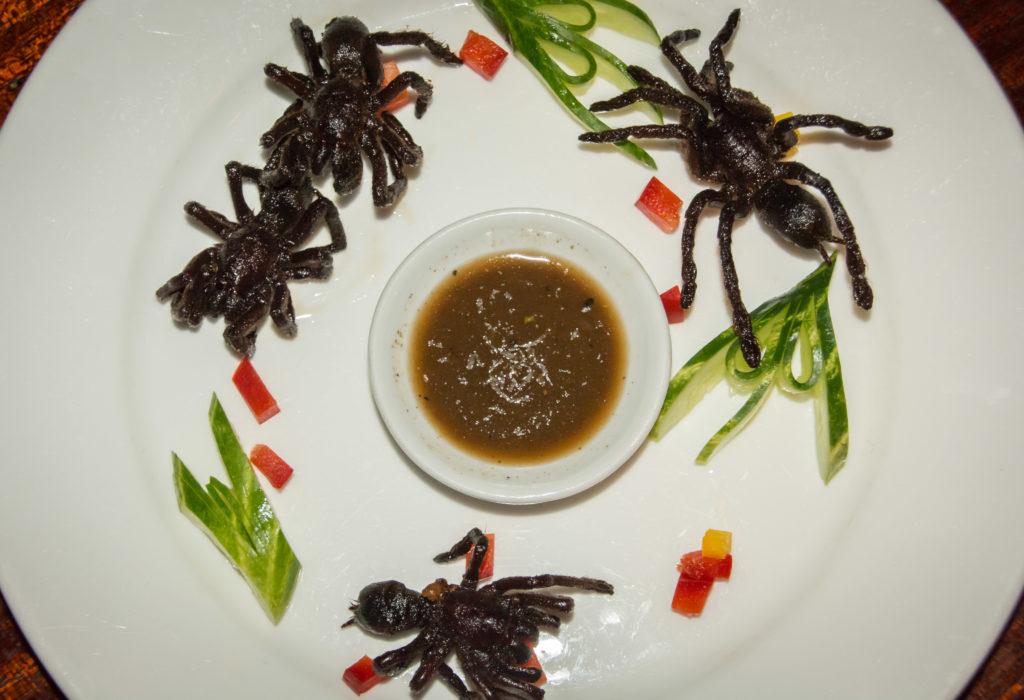Edible Spiders: Can you eat tarantula? Why, yes you can. In this article I’ll be eating spiders in Cambodia (Deep fried tarantulas) – In the capital city, Phnom Penh.
Surprisingly, this once hugely common dish has all but disappeared from major cities. We had to do some serious internet research to discover where to chew some tarantulas, without having to go out to rural areas.
We finally tracked down a restaurant that keeps many a live edible tarantula on the premises so that edible spiders are a permanent menu option. More on that below.
Eating Spiders: The Video
Eating Spiders – How To Cook Deep Fried Tarantula
Cyriopagopus albostriatus, or Haplopelma albostriatum, also known as the edible spider or Thailand Zebra Leg tarantula. It is a species of spider found in Myanmar, Thailand, and Cambodia.
Recipes vary, but it’s pretty straightforward stuff really. Dip the spider in some in a salty coating, normally a bit of MSG with salt, sometimes sugar and some chicken seasoning maybe garlic, either as a dry rub or mixed with a little water. Then deep fry the tarantula in hot oil for about 45 seconds.
This should make the outsides and legs of the edible tarantula very crispy and leave the insides a little soft.
Though you can find this dish roadside on carts and at street food markets, where you’ll just see spiders and other insects piled up on little carts, waiting to be quickly deep fried, for something this unappetising, we opted to visit a proper restaurant to try it.
Romdeng Restaurant in Cambodia’s capital, phnom penh is one of the few places we could find that has tarantula on their regular menu in a casual, clean environment. Romdeng is also an NGO restaurant that helps train street kids to cook so that they have skills for the future.
What do edible spiders taste like? Find out more below.
Eating Spiders Podcast
In This Episode:
- Tommo eats Tarantula in Cambodia
- How to cook and eat tarantula
- The history of eating tarantula and why it’s still eaten today

Listen & Subscribe: iTunes | Spotify | Google Play | Stitcher
RSS: https://feeds.captivate.fm/thedish/
Support: Become a Patron | Tweet: @foodfuntravel | Email: [email protected]
Eating Spiders – I Get A Taste Of Arachnid
So, they actually brought out 1 live tarantula on a plate first, it was scurrying about.
This tarantula species is dark grey and hairy. About 3 inches long (~7cm). It’s not pretty. It is not appetising. But, I had committed to spending $5 USD on a plate of 4 tarantulas, so I was going to eat them.
I have to say, whatever carnivore guilt I may feel for some animals humans eat, Spiders are probably at the very furthest end of the “actually I feel no remorse at all” scale, along with Scorpions.
Anyway, I don’t know if the little guy they brought out was actually my dinner, or whether he was their star actor spider that they brought out just for show, then take him back to his trailer to chill, while his friends deep fry.
A short while later, four tarantulas arrive on a white plate with a little dipping sauce and some salad garnish. Here’s what happened:
So, the legs were super crispy and really don’t taste of anything other than deep fried. The fangs and head, mostly the same. The abdomen was the strange bit, a bit less crispy, the innards are sort of poached inside. Not horrendous, but certainly not my gourmet choice. Maybe more of an acquired taste.
I’ve eaten insects before, deep fried spiders don’t differ too much. They lack any weird hairiness that you may expect and taste more of the oil they are fried in than of much else. I would say they are better in texture than crickets, grasshoppers or cicadas, simply because there are no chewy wings or shells to get stuck in your teeth.
A well cooked edible spider, surprisingly, melts in the mouth!
History Of Edible Spiders
So, why did Tarantula become a dish at all?
Edible tarantulas became a dish completely out of necessity. After Cambodia became independent from the French in 1953, life in the region didn’t improve. The fall out of the Vietnam war had terrible effects on Cambodia. Following that, in April 1975, dictator Pol Pot led the Khmer Rouge in taking over the country. His mission was to return Cambodia to an independent Agrarian way of life.
Borders were closed, the cities were emptied and people were sent to work in the fields. The intelligentsia and anyone who refused to go, were murdered in mass genocide.
The country was left with a mass of young, illiterate people, returned to a rural subsistence lifestyle. Much of the food that was farmed did not go to the farmers, and was taken by the ruling class.
Starvation was inevitable. Alternative food sources, that would not be confiscated, were the only way to survive. It’s possible that edible tarantulas had been eaten in Cambodia at least since the 19th century. On a diet of only a little bit of rice for rations, edible spiders are high in protein, folic acid and zinc. So in the late 70s they became a regular meal.
It wasn’t just edible tarantulas… Scorpions and other unlikely foods became part of the diet. Of these dishes, the ones that are still eaten today are those which locals actually found palatable. Yes, to those used to eating it, edible tarantula is a great beer snack.
Edible tarantulas are easy prey for humans. Locals living in the forest find them easy to catch. Digging up their burrows and catching them as they flee.
But sadly, the natural habitat is being destroyed. Cashew and rubber plantations, along with illegal deforestation, is destroying the environment where edible tarantulas once thrived.
The price of this local delicacy is rising and it will probably eventually become a specialist food, rather than a cheap street snack. That is still a way off for now though, but things could be changing fast.
Where to eat Edible Spiders (Deep Fried Tarantula) in Cambodia
So, where are people eating spiders? We have a few options in Cambodia for you!
We went to the pleasant surroundings of Romdeng restaurant in Phnom Penh, and easy and hygienic stop off for tourists passing through the capital. Its about $5 USD for 4 spiders.
The supposed epicentre of edible spider collection, is around the region of Kampong Cham, to the north east of Phnom penh. The roadstop village of Skun sometimes being dubbed “Spiderville” by locals and travelers. We didn’t make it there, but apparently they have enough spider snacks that they’ll be shouting you down in the street.
In Siem Reap, the busy city near Angkor Wat, there is actually a specialist Khmer Rouge cooking class, which helps tourists learn to cook some of the foods that Cambodians would have eaten at that time – Edible Spiders, grasshoppers and silk worms. It’s a protein feast. That class is bookable through backstreetacademy, but this is not a class we have personally taken.
Other than that, we did see carts with insects by the roadside in Phnom Penh, and in a few other towns. So you can just look out for them!
We saw a vendor (Pictured above) parked up on the main riverfront road somewhere between the south end of the Royal Palace and the Himiwari hotel. We’ve seen her on both sides of the street but she is the only vendor selling a whole variety of insects – so keep your eyes peeled. Street vendors move around, so she may not still be in the same spot.
—
Some of these foods might not agree with your stomach – so please be careful and always have travel insurance in case you get sick. We recommend World Nomads as they’ve always had our back.








